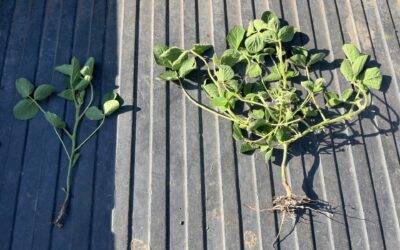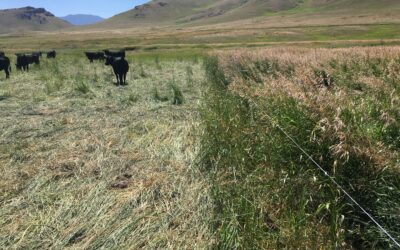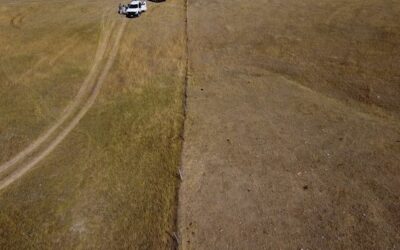Salinity
Managing Saline Soils in South Dakota: Part 1
Written collaboratively by Dwayne Beck and Ruth Beck.
Salts Occur Naturally in South Dakota Soils.
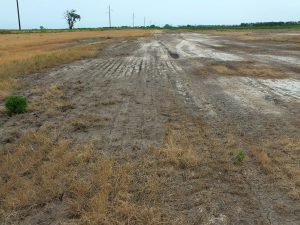 A soil has been described as a porous medium consisting of minerals, water, gases, organic matter, and microorganisms. The largest component of soil is the mineral portion, which makes up approximately 45% to 49% of the volume. Some of the mineral portion consists of primary mineral particles. These are the sand and silt particles. Some of the mineral portion is made up of secondary minerals that result from the weathering of primary minerals into secondary minerals like silicate clays. This process results in the releasing of important plant nutrient ions and other elements that make up the remainder of the mineral fraction. The ions attach to the soil clays and soil organic matter or react with other ions to form low-solubility compounds like lime (calcium carbonate) and gypsum (calcium sulfate). These compounds are correctly known as salts but are quite different from table salt (sodium chloride). When they are present at normal levels they help to stabilize the soil particles, buffer the soil pH, and serve as a source of soil nutrients. If these salts are not present in sufficient levels, nutrient deficiencies occur, soil pH is low, and soils may lack structure.
A soil has been described as a porous medium consisting of minerals, water, gases, organic matter, and microorganisms. The largest component of soil is the mineral portion, which makes up approximately 45% to 49% of the volume. Some of the mineral portion consists of primary mineral particles. These are the sand and silt particles. Some of the mineral portion is made up of secondary minerals that result from the weathering of primary minerals into secondary minerals like silicate clays. This process results in the releasing of important plant nutrient ions and other elements that make up the remainder of the mineral fraction. The ions attach to the soil clays and soil organic matter or react with other ions to form low-solubility compounds like lime (calcium carbonate) and gypsum (calcium sulfate). These compounds are correctly known as salts but are quite different from table salt (sodium chloride). When they are present at normal levels they help to stabilize the soil particles, buffer the soil pH, and serve as a source of soil nutrients. If these salts are not present in sufficient levels, nutrient deficiencies occur, soil pH is low, and soils may lack structure.
The reason for soil testing is to determine the level of soluble minerals in the soil so the ones in short supply can be added as fertilizers or other amendments. If certain elements are present in very high levels there may be problems with the availability of other elements due to competition or insolubility. Excess of other elements can lead to toxicity, high pH, or in the case of sodium, destabilization of the soil’s structure. If the concentration of all salts is too high their presence can hinder plant growth because the ions compete with plants for water. A soil conductivity test is used to determine the extent this is happening.
Soils that are very low in minerals under native conditions are usually also low in organic material. These soils require very large additions of fertilizers and other amendments like lime to make them suitable for crop production. Even when this is done, it is difficult to maintain productivity because the nutrients are easily lost. Similarly, soils that are very high in salts under native conditions are extremely difficult to convert to crop production without using extraordinary measures. Consequently, most of the soils that have been converted to crop production began with moderate levels of “salts”.
It is common for fields that have been cropped for long periods to experience issues with managing mineral elements. Many times the result is loss of nutrients due to leaching, erosion, or transport from the field in grain or biomass. This leads to lowered pH, soil structure degradation, and the need to add large amounts of lime, fertilizers, and other amendments.
In some cases cropped soils begin to develop saline seeps. Some saline seeps develop as a result of excess water due to improper management of the water cycle by the land managers. Other times off-site influences like road and drainage ditches, shelterbelts, ponds (man-made or natural) and/or mismanagement of the water cycle by neighboring property owners can also result in the development of saline seeps. One of the main sources of excessive salinity issues in agriculture is irrigation because it adds salts in the irrigation water to those in the soil.
It is important for landowners to act quickly when they suspect their land is being adversely impacted by salinity. The first step is to do a thorough job of sampling the soil in the field to determine the location, degree, type and extent of the problem. Using Web Soil Survey to identify the soil types and topography of the field will be helpful. Obtain help from NRCS or SDSU Extension personnel staff in interpreting the results. It is important to determine why the problem is occurring before trying to find a solution. One thing is certain, adding more salts (gypsum or other amendments) to a soil that is already impacted by salt is not the correct approach. You need to figure out what is going on before trying to solve it. There are no one-time answers.
This Page Was Created Utilizing Text And Images From These Sources:
South Dakota Resource Concerns Webpage, South Dakota Natural Resources Conservation Service
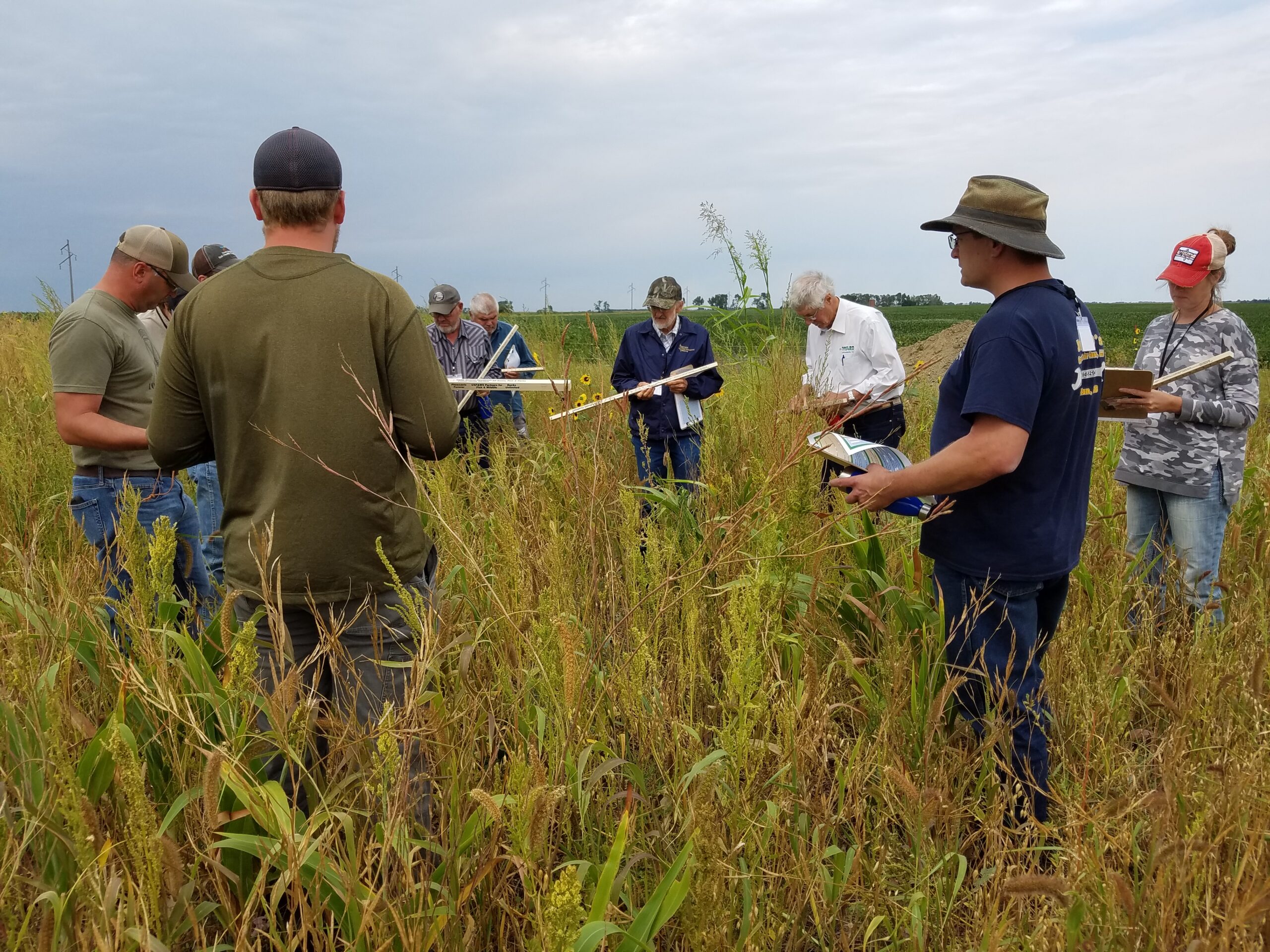
West River Soil Health School Registration Open!
In 2024, the South Dakota Soil Health Coalition will host an additional Soil Health School in west of the Missouri River! The 2024 West River Soil Health School with be held June 26-27 near Caputa, SD! This school will focus on issues specific to the land, climate, and ag production systems of wester South Dakota. Class size is limited, so early registration is strongly encouraged!
News & Events
Farmer reaps higher yields by interseeding soybeans
By Stan Wise Alex Frasier has spent a lot of time studying what it takes to grow a successful crop. After studying ag production and precision technology at Lake Area Technical College, he has worked in ag retail and currently works as an agronomist in Aberdeen, SD....
Farm and ranch innovators to share new ideas at Soil Health Conference
By Stan Wise PIERRE, SD — Before Cooper Hibbard came home to manage his family’s ranch, he studied ag business, rangeland resources and Spanish at California Polytechnic State University and then worked on ranches all over the world. That education and experience...
Wintertime is decision time
By Stan Wise PIERRE, SD – It’s often said that the best time to start improving your land was 20 years ago, but the second-best time is right now. That statement might be harder for ranchers to swallow with winter on their doorstep, nothing growing in their pastures,...
